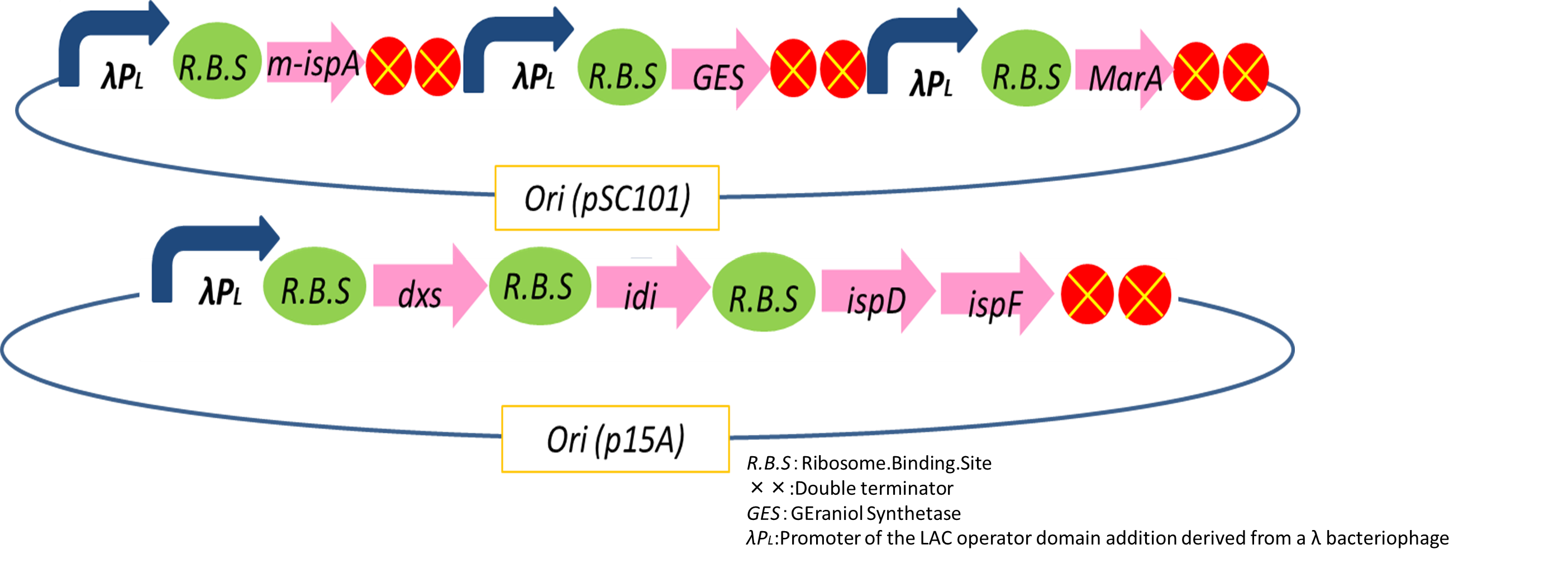Team:Nagahama/Description
香蔵庫(KOZOKO)
~This is our new HERO!!~
Project
We examined the antibacterial activity of volatile substance to realize Kozoko. The Result suggested that volatile substance of the wasabi, rose, garlic and onion have antibacterial properties. Then, we attempt to identify antibacterial volatile by literature search. Wasabi, rose, garlic and onion have Allyl isothiocyanete, geraniol, allicin, lachrymaltory-factor respectively.
Synthesis of antibacterial volatile has many complicated things, so the synthesis requires various enzymes and precursor. Further, We researched weather synthesis of antibacterial volatile will succeed or not in E.coli. The result, E.coli synthesize precursor of geraniol (geranyl diphosphate,GPP). We understood that E.coli can synthesize geraniol using one enzyme.
So, we designed system that biosynthesizes geraniol in E. coli.
We transferred
1. geraniol synthase gene (from Ocimium basilicum).
2. isoprenoid pathway such as MEP pathway gene (dxs, ipsD, ispF, idi, ispA) to biosynthesize GPP that is precursor of geraniol.
3. positive transcription factor of AcrAB-TolC efflux pump gene (MarA) to enhance geraniol tolerance and export geraniol out of cells.
Plasmid
(The under)Geraniol synthesis circuit. m-ispA which we improved to synyhesize only GPP, and not to synthesize FPP、GES derived from Ocimum Basilicum、we let Escherichia coli overexpress transcription factor MarA letting the expression of pump that the film outside exhausts geraniol activate. (The below)MEP strengthening path way。We can let Escherichia coli make materials GPP of various terpenoids, FPP, GGPP in large quantities by strengthening MEP course.
Back Ground
We
MEP Pathway
A non-mevalonate (MEP) path way is a biosynthesis path way of isopentenyl diphosphate (IPP) and dimethylallyl diphosphate (DMAPP).
It is the slightly complicated synthetic path way with six intermediary metabolite before Escherichia coli synthesizes IPP and DMAPP.
A path way synthesizing same IPP and DMAPP includes a mevalonate path way.
The difference of these path way is two.
The first difference.
A starting material is the acetyl CoA of 3 molecules by the mevalonate path way.
In contrast, a starting material is pyruvic acid and Glyceraldehyde 3-phosphate by the non-mevalonate pathway.
The second difference.
It is a mevalonate pathway to make mevalonic acid a biosynthesis intermediate.
That does not make a biosynthesis intermediate is non-mevalonate pathway.
Many bacteria and chloroplast of plants has the non-mevalonate pathway.
Escherichia coli synthesizes IPP and DMAPP necessary to produce beta-carotene and quinone or terpene by non-mevalonate pathway.
Project Description
Tell us about your project, describe what moves you and why this is something important for your team.
What should this page contain?
- A clear and concise description of your project.
- A detailed explanation of why your team chose to work on this particular project.
- References and sources to document your research.
- Use illustrations and other visual resources to explain your project.
Advice on writing your Project Description
We encourage you to put up a lot of information and content on your wiki, but we also encourage you to include summaries as much as possible. If you think of the sections in your project description as the sections in a publication, you should try to be consist, accurate and unambiguous in your achievements.
Judges like to read your wiki and know exactly what you have achieved. This is how you should think about these sections; from the point of view of the judge evaluating you at the end of the year.
References
iGEM teams are encouraged to record references you use during the course of your research. They should be posted somewhere on your wiki so that judges and other visitors can see how you though about your project and what works inspired you.
Inspiration
See how other teams have described and presented their projects:


